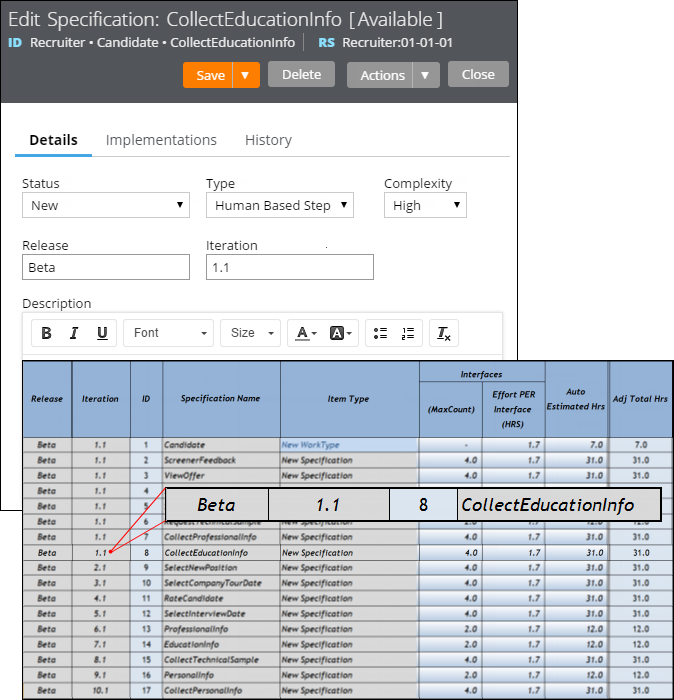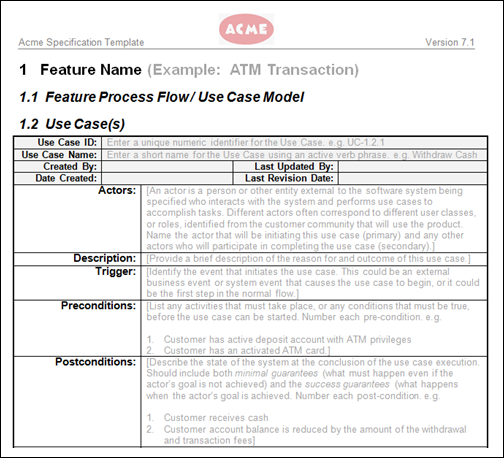Tracked changes persist between client sessions
Valid from Pega Version 7.1.7
The Microsoft Word native change tracking feature persists between client sessions for specifications. Enable this feature to facilitate collaborative reviews of your specifications with project stakeholders.
Inserting your specification updates as tracked changes allows you to:
- Provide visible markup to the next reviewer.
- Correlate edits to a specific user and time.
- Generate documents that include markup and comments.
Local settings, such as the colors you specify for markup, do not persist between clients.
For instructions on how to prevent markup and comments from appearing in generated documents, see Advanced options for editing specifications.
Add multiple attachments at once
Valid from Pega Version 7.1.7
You can now add more than one attachment to a requirement or specification at a time, without closing the Add/Edit Attachment modal dialog box. Use the traditional browse method to upload an attachment or drag and drop a local file, based on your needs. View and access your attachments from the Application Profile landing page, Requirement form, or Specification form.
Plan projects using release data
Valid from Pega Version 7.1.7
Requirements and specifications can now be mapped to a target release and iteration within a specific release. Populating these fields allows you to set and publish a release schedule through worksheets generated by the Sizing wizard. Access these fields from the Application Profile landing page or by opening any requirement or specification.

The Release and Iteration fields as they appear in a specification and a corresponding worksheet
The Sizing wizard incorporates values from the Release and Iteration fields for specifications only.
Specification type extended for decisioning users
Valid from Pega Version 7.1.7
Specifications now support a Decision Strategy Manager (DSM) type. This allows you to map your specifications to a decisioning component, such as a strategy or model. After you select an appropriate subtype and provide relevant metadata, you can run the Sizing wizard to incorporate these details into project sizing worksheets.

DSM specification details as they appear in the Specification form and Sizing wizard output
You must have access to Decision Management rulesets to create DSM specifications. For more information on specification types, refer to the Details tab of the Specification form. To view all specifications in your application, filtered by type, refer to the Application Profile landing page.
Add collections as linked implementations
Valid from Pega Version 7.1.7
You can now identify a collection or individual steps within a collection as an implementation of a specification. Linking specifications to rules allows you to more accurately convey your application design to project stakeholders. Use the Specifications tab on the Collection form to create these links.
To see all implementations for a given specification, refer to the Application Profile landing page or the Implementations tab of the Specification form.
Add project branding to generated documents
Valid from Pega Version 7.1.7
The standard Word Template for specification descriptions is now extensible. Using a customized template allows you to brand your generated documents with project-specific elements.
Specialize the Rule-Application-UseCase.pySpecificationDescription rule to:
- Include relevant images such as company logos.
- Define static text.
- Insert dynamic elements by merging clipboard values into field codes.

Generated document with custom company logo
Refer to Advanced options for editing specifications for instructions on how to override this template.
App Studio enhancements further support Pega Express methodology
Valid from Pega Version 8.6
App Studio now includes improvements that you can use to plan your Microjourney™ in a more convenient way. The Overview workspace now includes a button to edit application details, such as name, description, and business objectives, without having to switch to Dev Studio. You can also access relevant information faster, because Case Designer displays additional details about channels, data objects, and attachments associated with a case type directly in a properties pane. For improved management of your features, feature categories are now available in the application inventory so that you can clearly communicate to your development team what type of features need implementation.
For more information, see:
- Editing application details in App Studio
- Associating personas with channels
- Adding features to application inventory
- Creating a Microjourney for customer success
Enhanced mapping of personas and users in App Studio
Valid from Pega Version 8.6
App Studio now provides a consistent and transparent experience when mapping personas to users. When you invite users to your application, you can associate each user with a run-time persona or developer role by selecting an option from a clearly organized list. For example, you can associate run-time users with a customer service representative persona, and then invite a person to help develop your application and assig them a developer role. For greater clarity, personas now replace references to roles in App Studio.
For more information, see Inviting collaborators to your application.
Tracer support for Cosmos React
Valid from Pega Version 8.6
The Tracer tool is now available for stateless applications, so that you can trace and debug applications that you build on Cosmos React. Because in a stateless application multiple requests can run simultaneously, to provide clarity, Tracer shows the events by request ID instead of grouping the events by the time of occurrence. For greater convenience, debugging Cosmos React applications is also available in an offline Tracer tool. As a result, you speed up the development process and deliver top-quality applications that are free of bugs.
For more information, see:
- Debug your Cosmos React applications faster with Tracer (8.6)
- Application debugging by using the Tracer tool
- Pega Digital Experience (DX) API
- Cosmos React
Nested conditions visible in the condition builder
Valid from Pega Version 8.6
Condition builder now supports the option to view nested conditions in a read-only mode, so that you can conveniently analyze and understand logic in your application. For example, if you create a condition that uses another When condition rule as a value to compare at run time, you can preview the configuration of that When condition. You can use this feature with When conditions nested at multiple levels, so that you can analyze even complex logic in your application.
For more information, see Defining conditions in the condition builder.

